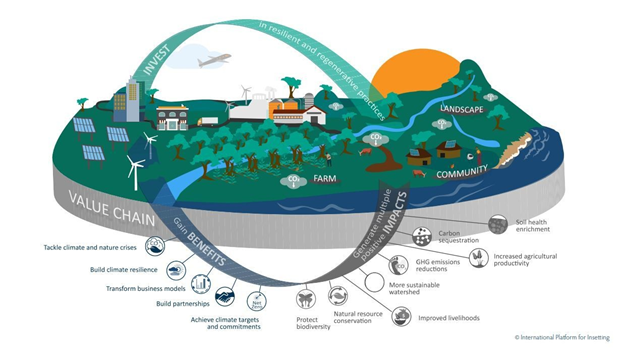As private sector entities strive for carbon neutrality, voluntary offsetting through carbon credits has become a popular means to achieve this goal. The concept is simple: one company offsets its unavoidable emissions by purchasing carbon credits from another engaged in renewable energy or environmental initiatives. For instance, a company might fund a new solar plant through another’s carbon credits. However, this seemingly straightforward exchange is fraught with complexities, such as the risk of double-counting emissions reductions and the challenge of ensuring additionality—ensuring that offset projects go beyond business as usual.
The urgent need for companies and countries to identify high-integrity projects that adhere to robust climate methodologies is more apparent than ever. Amidst this quandary, another approach emerges: Carbon Insetting. This article explores the nuances of Insetting versus Offsetting, shedding light on the intricacies and considerations that underpin the journey to a sustainable and carbon-neutral future.
Carbon Offsetting: A Double-Edged Sword in the Climate Battle
Offsetting involves compensating for one’s carbon emissions by investing in projects or initiatives that reduce or capture an equivalent amount of greenhouse gasses elsewhere. By offsetting, companies are able to purchase carbon credits from others actively engaged in emission reduction efforts, thereby supporting and indirectly contributing to climate change mitigation. This often includes supporting renewable energy projects, reforestation efforts, or methane capture initiatives. Offsetting is akin to a financial transaction, where the buyer pays for carbon reduction or removal activities to balance out their own emissions.
The concept is both ingenious and controversial, functioning as a marketplace where entities can buy, sell, and trade carbon credits. On one side, it serves as an incentive for organizations to maintain or intensify their climate-centric initiatives. Conversely, it creates a dynamic where some entities may opt for the simpler route of purchasing credits rather than actively reducing their emissions. This dual nature of carbon offsetting raises critical questions about its efficacy as a standalone solution in the global pursuit of climate resilience.
While carbon offsetting plays a role in motivating climate-friendly activities, it falls short as a comprehensive substitute for direct emissions reductions. The urgency to combat climate change necessitates a shift beyond mere offsetting towards the decarbonization of entire value chains. It becomes imperative for organizations to incorporate nature-positive solutions and operations, contributing not just to emission reduction but also to the regeneration of ecosystems.
The real need lies in adopting inherently constructive approaches that go beyond mitigating emissions and actively work in harmony with the earth. The emphasis should pivot towards holistic and sustainable practices that address the root causes rather than merely alleviating their symptoms.
Carbon Insetting: A Path to Harmonious Sustainability
Carbon Insetting, an innovation in the realm of carbon reduction, involves companies funding their own projects within their supply chain or in local communities where they or their suppliers operate. Unlike offsetting, where companies purchase carbon credits from external projects, insetting empowers companies to directly invest in and control their carbon avoidance or removal initiatives.
Nadine Stueber, Nestlé’s Global Insetting & Offsetting Manager, defines insetting as “carbon removals connected to our value chain.”
Insetting involves the implementation of nature-based solutions like reforestation, agroforestry, renewable energy, and regenerative agriculture, marking a shift from doing less harm to actively doing more good. It encourages companies to evaluate their carbon emissions comprehensively and take tangible steps to reduce their environmental footprint.
This involves initiating impactful socio-environmental projects that not only contribute to a sustainable value chain but also enhance the livelihoods of Indigenous communities and individuals along the supply chain. The essence of insetting lies in harmonizing companies with nature, fostering a symbiotic relationship that benefits both businesses and the environment.
When engaging in carbon insetting, companies typically assess their internal emissions and implement measures to minimize them. This process often necessitates collaboration with third-party experts and the use of carbon accounting software to analyze scope 1, scope 2, and crucially, scope 3 emissions. By reducing emissions internally, companies not only contribute to the fight against climate change but also enhance the efficiency of their supply chain.
Examples of carbon insetting initiatives include hotels planting trees in their surroundings or restaurants growing their own produce to reduce dependence on external suppliers. By minimizing the need for excessive transportation and sourcing locally, companies actively work towards reducing their carbon footprint.
Long-Term Benefits of Insetting
While offsetting remains a popular choice due to its immediacy and flexibility, the advantages of insetting become apparent when considering long-term climate action goals. Insetting allows companies to build internal assets that generate carbon credits within their own value chains. This approach grants them resilience against potential rises in carbon credit prices over time.
Nadine emphasizes the unique suitability of insetting for companies in the food and agricultural sector, stating, “Through insetting projects, we can address carbon impacts in these landscapes while promoting social and environmental safeguards, sustainable livelihoods, economic development, and biodiversity.”
Pros and Cons of Insetting vs. Offsetting
Offsetting Advantages:
- Diversification: Offset projects allow companies to diversify their climate investments, contributing to a range of projects aligned with their values and interests.
- Global Impact: Offsetting allows individuals and organizations to support projects around the world, contributing to a global reduction in carbon emissions.
- Immediate Action: Offsetting enables a swift response to carbon emissions, providing a tangible and immediate impact. Companies can swiftly purchase carbon offsets through voluntary carbon markets.
Insetting Advantages
- Total Ownership: Insetting provides companies with complete control over the type and location of their projects, fostering a sense of ownership and commitment.
- Relevance and Impact: By keeping projects close to home, insetting addresses the criticism of offsetting as a ‘license to pollute.’ It creates a more relevant and meaningful impact for employees and stakeholders.
- Holistic Approach: Insetting encourages organizations to analyze and reduce emissions throughout their supply chains, fostering a comprehensive, long-term sustainability mindset.
- Operational Efficiency: By optimizing internal processes, companies can achieve cost savings while simultaneously reducing their carbon footprint.
Cons of Insetting:
- Scope Limitations: Insetting may be challenging for companies with limited opportunities for direct emissions reduction within their operations.
- Resource Intensity: Implementing insetting strategies may require substantial investments and resources to achieve meaningful emissions reductions.
Cons of Offsetting:
- Ethical Concerns: Some critics argue that offsetting may provide a false sense of environmental responsibility, allowing emitters to continue their polluting activities.
- Additionality Issues: The effectiveness of offset projects is contingent on the concept of additionality, meaning that the emission reductions achieved would not have occurred without the offset funding. However, ensuring additionality can be challenging.
Choosing the Right Path: Balancing Insetting and Offsetting
As we strive for a sustainable future, debate between insetting and offsetting underscores the need for multifaceted solutions. This suggests that the choice between insetting and offsetting need not be exclusive. Companies committed to reducing their carbon footprint and achieving net-zero emissions can benefit from a balanced integration of both strategies. While offsetting contributes to global carbon reduction efforts, insetting emphasizes the integration of sustainability into the very fabric of an organization. Striking the right balance between these two approaches is essential for businesses and individuals to make meaningful contributions to the fight against climate change.
Photo Credit: Weforum
Found it interesting and would like more in the mail?




